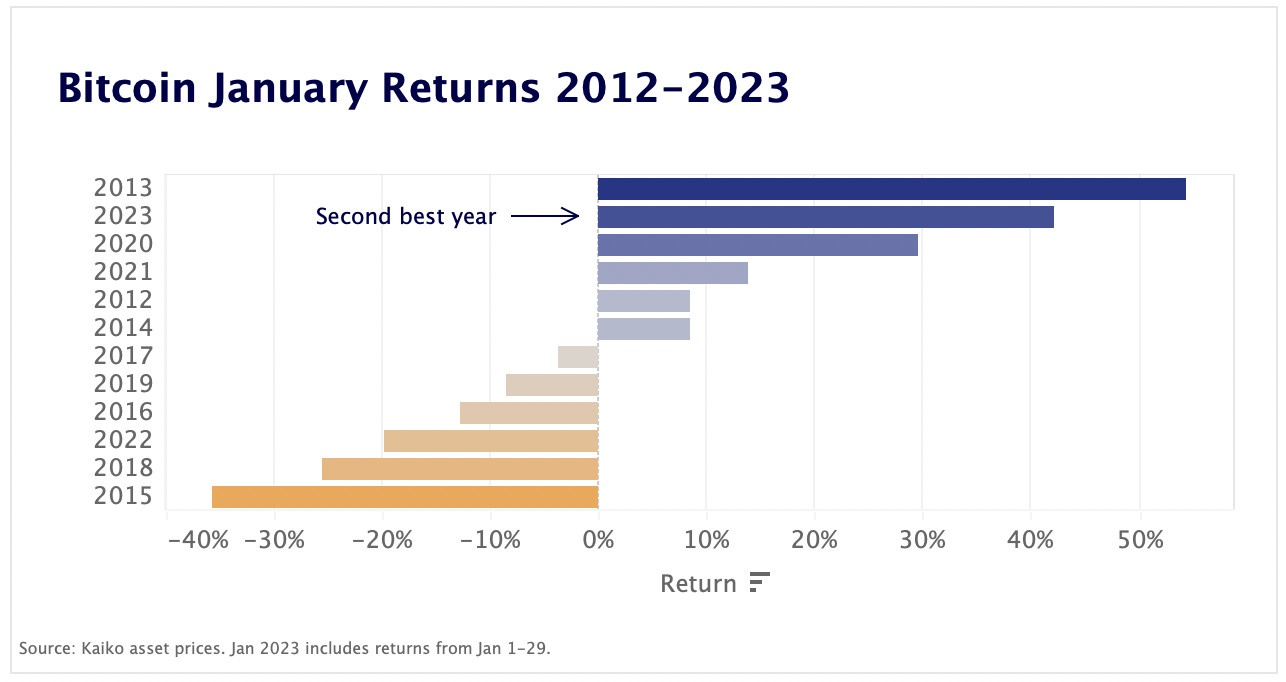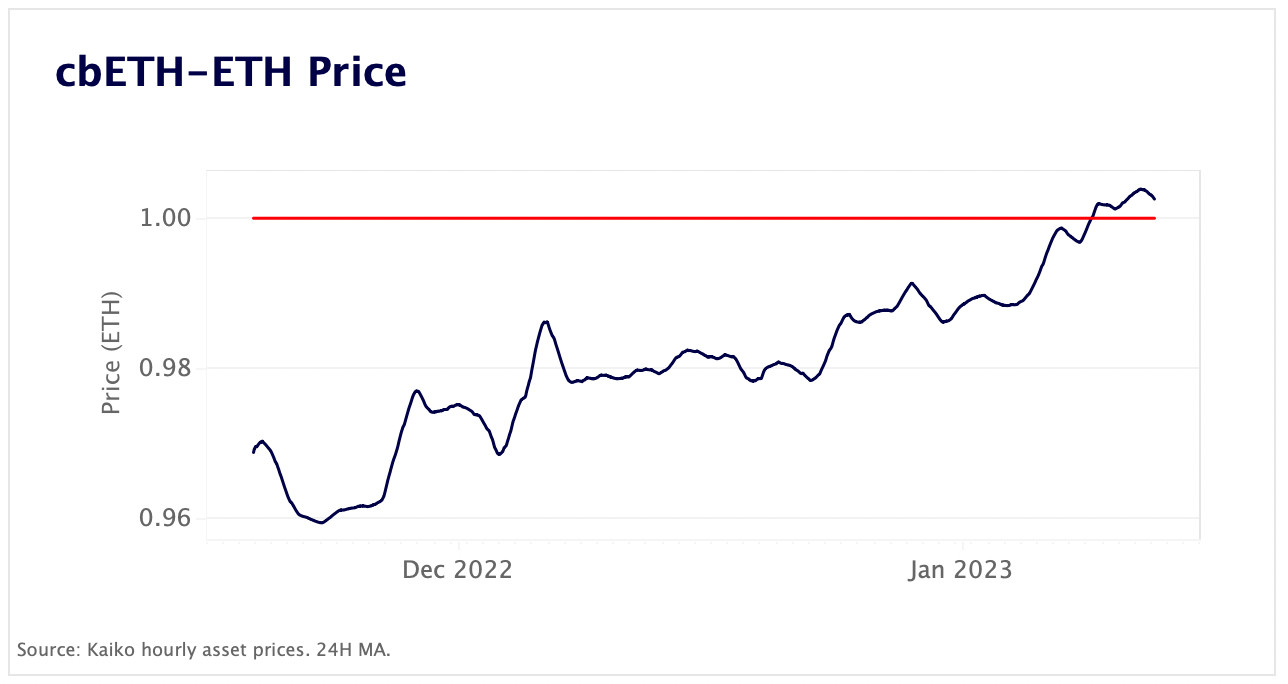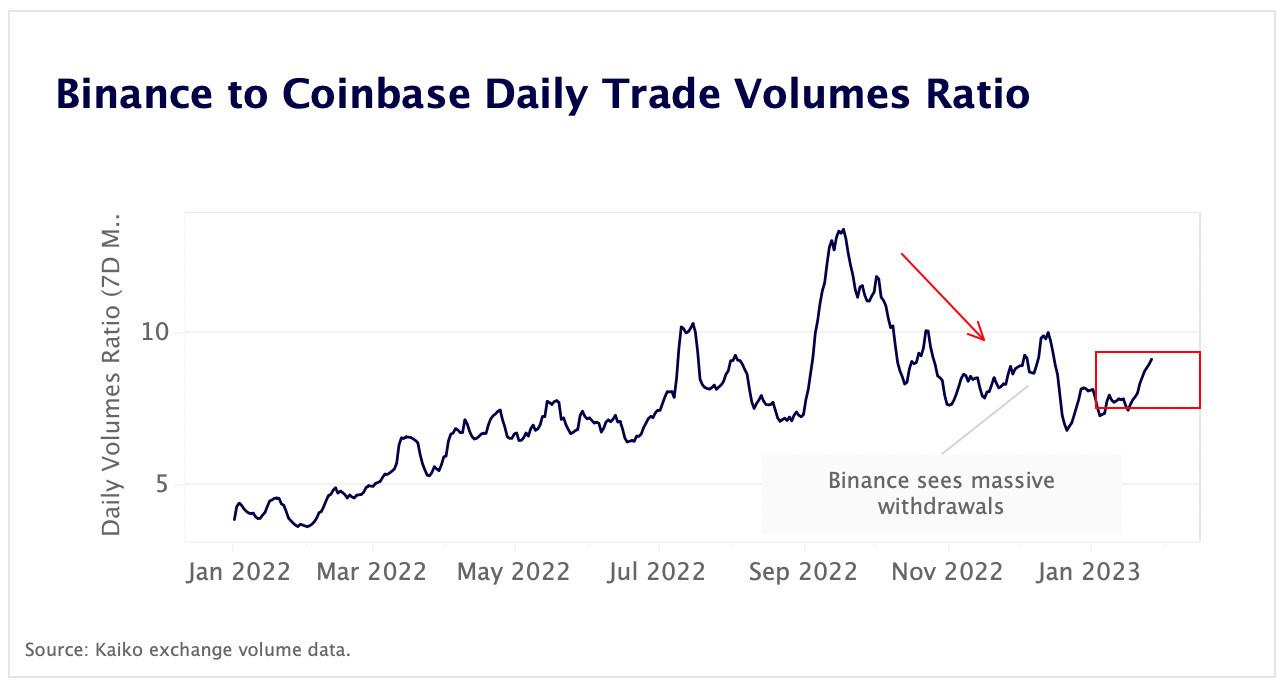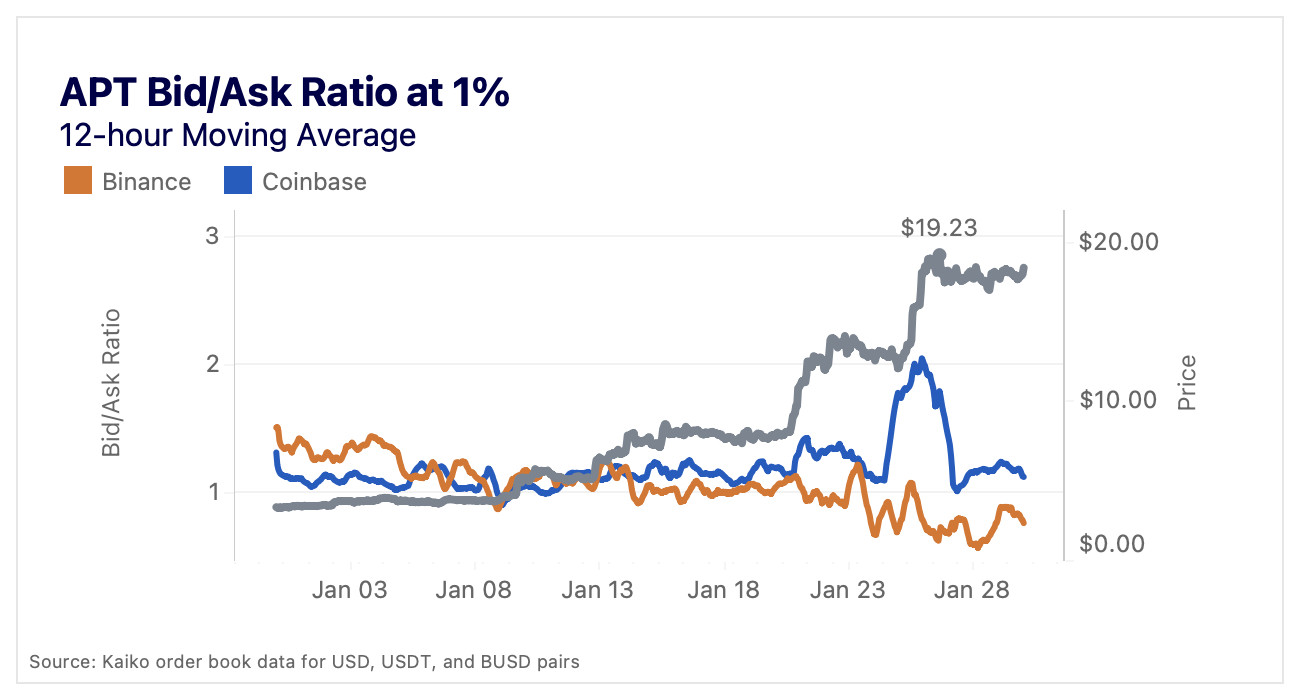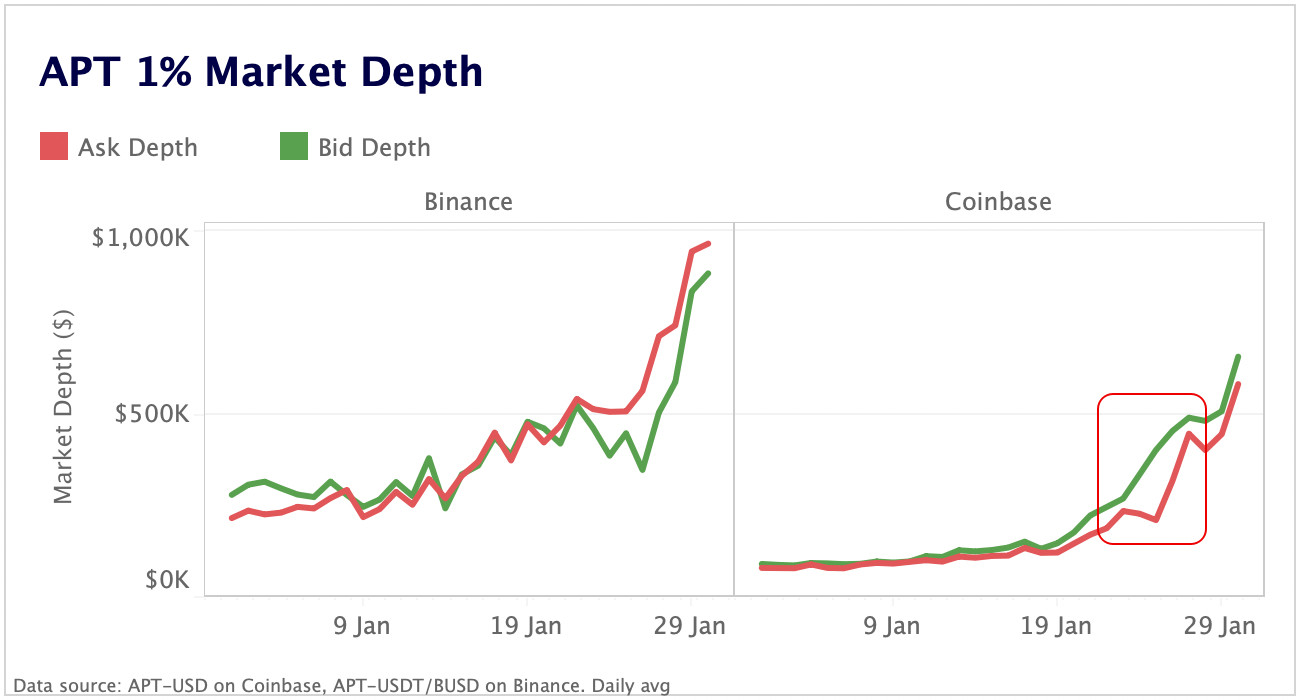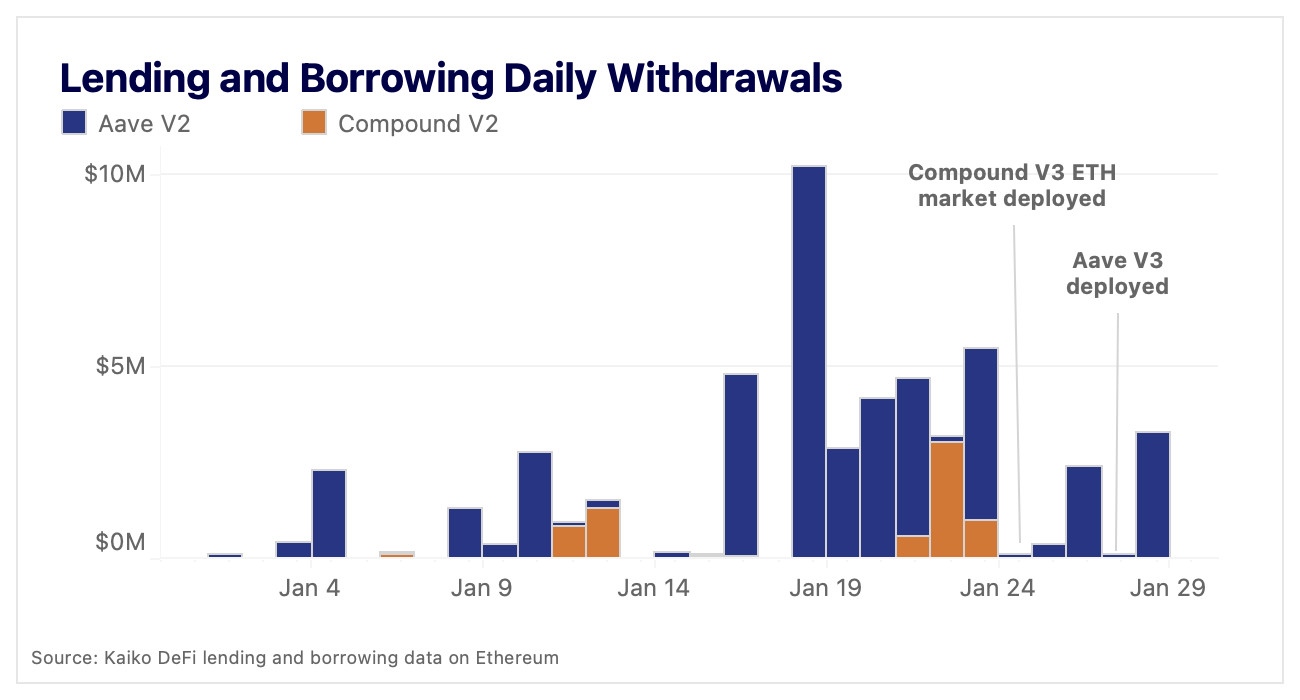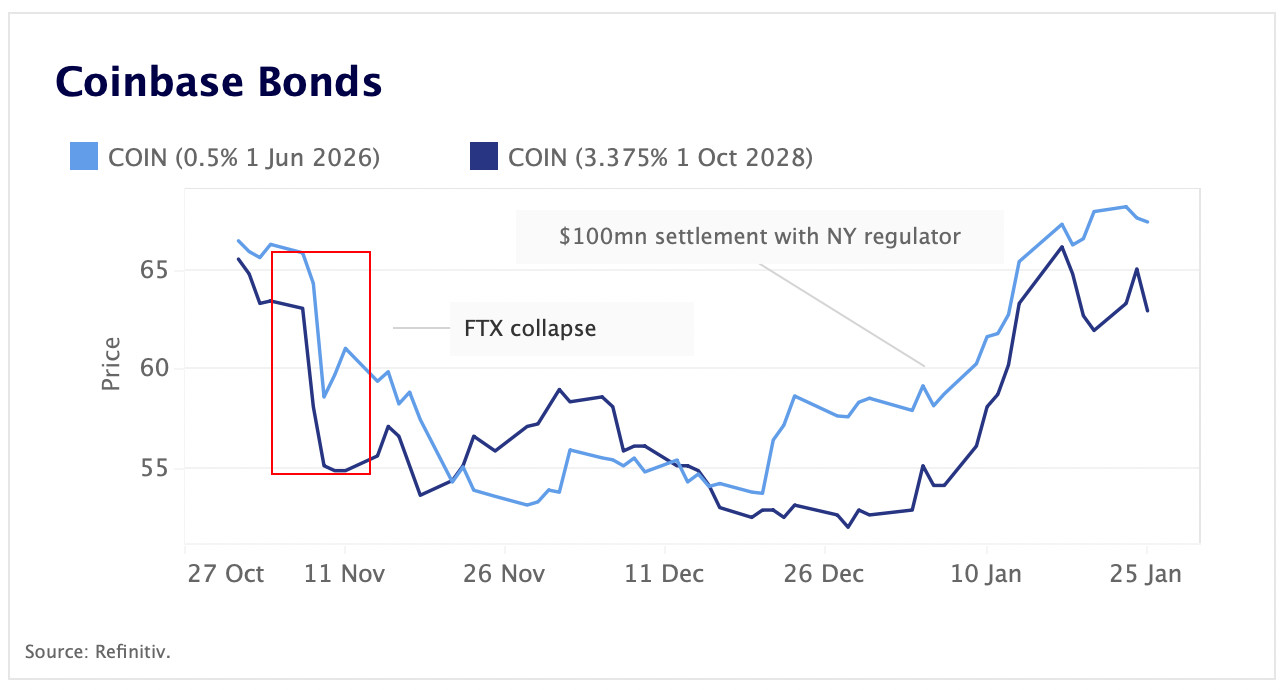A summarizing review of what has been happening at the crypto markets of the past week. A look at trending sectors, liquidity, volatility, spreads and more. The weekly report in cooperation with market data provider Kaiko.
The last 7 days at the cryptocurrency markets:
- Price Movements: BTC is up over 40% YTD and is well on track for its second-best January in the past ten years.
- Market Liquidity: Market depth for APT order books has dropped sharply on both Coinbase and Binance, despite the token hitting all time highs.
- Derivatives: ETH option markets are expecting short term volatility as call volumes dominate.
- Macro Trends: Coinbase bond prices are recovering from December lows, but investors are still cautious.
BTC approaches $24k
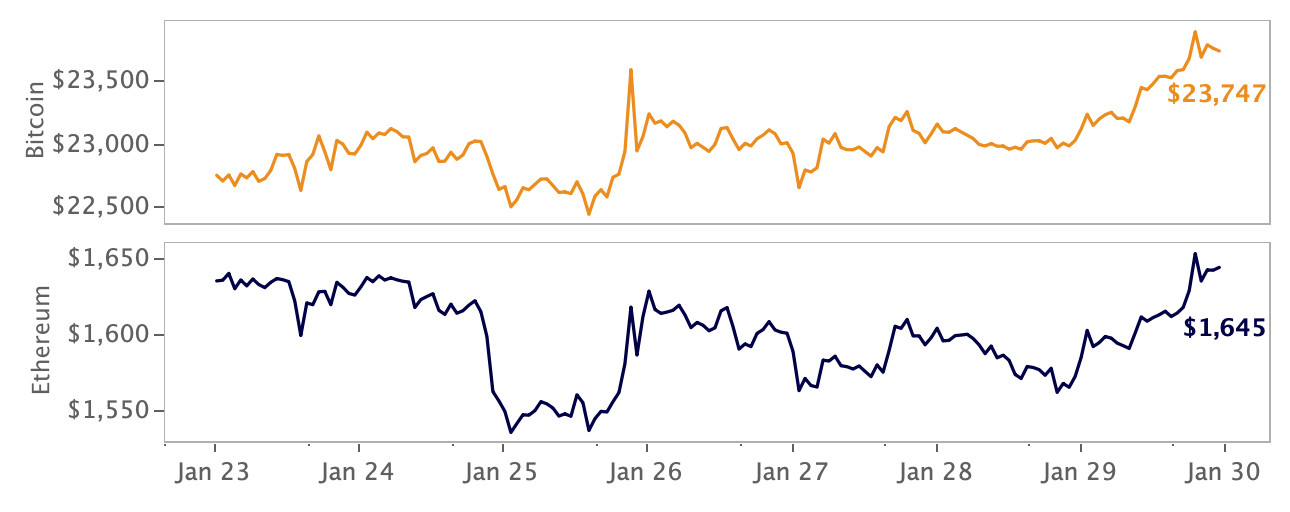
After soaring 10% last week, Bitcoin (BTC) continued its positive momentum with a more modest week, up 1.9% and reaching a 5 month high of $23,900 in the process. It was also a good week for altcoins with Aptos' APT leading the pack, up 36% on the week. In other industry news, Binance admitted to storing users funds alongside collateral in an error, Moody’s is reportedly working on a scoring system for stablecoin reserves and Bithumb was raided in South Korea as part of a price manipulation probe.
Bitcoin on track for its second best January since 2012
Bitcoin is up over 40% YTD and is well on track for its second-best January in the past ten years. While BTC still trades below its 2022 highs of $24.5K, the current rally has far outpaced all other relief rallies we've seen over the past year. The broader crypto market recovery comes amid a positive shift in risk sentiment after U.S. inflation showed convincing signs of easing over the past few months.
Coinbase's cbETH trades at a premium for the first time ever
Coinbase’s liquid staking derivative cbETH traded at a premium to Ethereum (ETH) for the first time since its inception. Unlike market leader Lido Staked Ether (stETH), which uses a rebase mechanism to increase stETH balances in accordance with staking yield, 1 cbETH represents 1 staked ETH plus all of its accrued staking interest since the token's launch in June 2022. This means that cbETH’s price will likely continue to increase against ETH as it accrues staking yield. One caveat to this model is high fees: Coinbase takes a 25% fee from staking rewards associated with its token, compared to 10% by Lido (stETH) and 5% by Binance (bETH). Check out our deep dive on liquid staking derivatives here.
Upbit dominates Axie Infinity (AXS) trade volume
Metaverse tokens have performed exceptionally well since the start of the year, led by Axie Infinity’s AXS. AXS is up more than 90% YTD, a remarkable surge considering nearly 2% of the token’s supply was just unlocked, which is typically a bearish event. ENJ, MANA, and SAND are also up double digits in 2023.
To understand the origins of this bull rally, we looked at trade volume across 10 exchanges and noticed that Upbit, one of the largest crypto exchanges in South Korea, boasted the highest volumes for metaverse-affiliated tokens, specifically for AXS. Typically, Binance dominates trading activity across all sectors, thus the trend suggests that the Korean region has a particular affinity for the metaverse. Daily volumes crossed $600mn for the four tokens on January 22-23, nearly double the volumes on Binance over the same time period.
So why Upbit? We couldn't find any direct link between the company and the exchange, beyond an interview last August where the co-founder claims to want to "double down" on the Korean market. Perhaps that strategy worked, and has helped boost AXS' price in the meantime.
Binance (re)gains momentum in January
Despite a wave of negative news, trading activity on Binance has been gaining traction in January. The ratio of daily trade volumes on Binance versus Coinbase, has been trending upwards over the past few weeks after experiencing a sharp dip in Q4 of 2022. The ratio increases when trade volumes on Binance accelerate relative to Coinbase and vice-versa. The Binance to Coinbase volume ratio rose in the first nine months of 2022, hitting a two-year high in September. Coinbase has suffered a drop in activity and falling share price amid the bear market, while Binance has managed to continue attracting strong inflows.
APT liquidity analysis: what's causing the surge?
The Aptos blockchain's native APT token has surged to all time highs since the start of the year, without any significant changes in fundamentals. The blockchain is backed by big names such as Andreessen Horowitz, Jump Crypto, and FTX, but the network's ecosystem development remains relatively subdued. To understand APT's extraordinary rally, we look at order books on Binance and Coinbase, specifically the bid-ask ratio. When the ratio is above 1, there are more bids than asks on APT order books, which means there is less resistance towards the upside.
Last week, Coinbase’s bid/ask ratio for the APT-USD trading pair nearly doubled right before APT's price surged from $10 to $19. This suggests a temporary bid wall could have supported APT's extended rally. While the trend is a bit odd, Coinbase only accounts for a small fraction of total trade volume. Meanwhile, the bid/ask ratio on Binance has steadily declined from 1.5 at the start of January to a low of 0.565 on January 28, meaning there is an imbalance favoring the ask side (more resistance to the upside).
APT prices remain high, so it seems Binance's imbalanced order book has not been a roadblock to the gains we are seeing. What's interesting is that overall, APT market depth has fallen considerably on Binance over the past month when measured in native units (APT) on the order book. On Coinbase, market depth has climbed ever since the imbalance first emerged from January 24-26.
When looking at market depth denominated in U.S. Dollars, we see another story that closely matches the token's meteoric rise. On Binance, the $ value of APT market depth has climbed from ~$250k on the bid/ask side to nearly $1mn, which suggests market makers reduced the quantity of APT on order books to account for the rally.
Another source for the rally could be the surge in APT activity on Upbit, which we find curious because a similar trend is also observed for AXS. However, Korean exchanges are relatively isolated from global crypto markets due to stringent capital controls in the region, so the bulk of price discovery tends to happen on global exchanges like Binance.
Aave and Compound V3 deployments have minimal impact on V2 markets
Aave and Compound, the two largest DeFi lending and borrowing protocols, each deployed new V3 markets last week with minimal impacts on V2 markets. Compound’s V3 requires new deployments for each borrowable asset – it had already deployed USDC – and last week launched its ETH market. The market has since attracted 7k cbETH and 6k stETH as collateral, or about $22mn, with 9k ETH borrowed. Aave released its V3 on Ethereum (after previously deploying it on Optimism, Polygon, Avalanche, and Arbitrum) on January 27. It attracted $40mn in collateral in the first two days after release. However, when examining the V2 markets, we can see that neither protocol registered significant outflows in the form of token withdrawals. Aave V2 holds $5.5bn and Compound V2 holds $2.2bn, and we will continue to closely monitor repayments and withdrawals on these protocols to gauge adoptions of V3 markets.
Coinbase bonds recover post-FTX collapse
Coinbase convertible bonds prices have recovered in January from record low levels reached after the FTX collapse. The increase comes after the exchange reached a $100mn settlement with New York financial regulator which has removed some regulatory uncertainty for investors. Bonds maturing in 2028 rose 19% in January to 63 cents on the dollar after hitting an all-time low of 52 cents at the end of Dec. Bonds maturing in 2026 were also up 16% nearing 68 cents on the dollar.
Overall, yields, which move in the opposite direction to prices, remained above 12%. This is nearly double the yields of other bonds with BB ratings, a sign that investors still consider that Coinbase securities could be downgraded.


